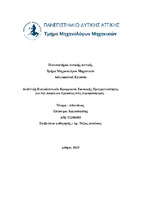Ανάπτυξη εκπαιδευτικών εφαρμογών εικονικής πραγματικότητας για την ασφάλεια εργασίας στις αερομεταφορές
Development of virtual reality educational applications for occupational safety in air transport

Διπλωματική εργασία
Συγγραφέας
Καλουδιώτης, Αθανάσιος
Ημερομηνία
2025-02-27Επιβλέπων
Νάζος, ΑντώνιοςΛέξεις-κλειδιά
Εικονική πραγματικότητα ; Ασφάλεια εργασίας ; Εκπαίδευση ; Αερομεταφορές ; ΑεροπορίαΠερίληψη
Στην παρούσα Διπλωματική εργασία θα περιγραφούν και θα αναλυθούν οι πρακτικές που ακολουθούνται στην εικονική πραγματικότητα και θα παρουσιασθούν τα πλεονεκτήματα, τα μειονεκτήματα, οι επιπτώσεις στην κοινωνία, τα εργαλεία και οι πόροι ανάπτυξης καθώς και οι εφαρμογές της. Επίσης η εφαρμογή της εικονικής πραγματικότητας στην εκπαίδευση και οι θετικές και αρνητικές επιδράσεις. Θα γίνει ανάπτυξη για την εκπαίδευση ασφαλείας στις αερομεταφορές, όπου θα περιγράφεται η ανάπτυξη ενός συστήματος, οι επιπτώσεις των νέων εφαρμοζόμενων τεχνικών στην ανάπτυξη της εκπαίδευσης , η τεχνολογία που θα χρησιμοποιηθεί καθώς και οι προκλήσεις και οι προοπτικές. Τέλος θα αναφερθούν τα συμπεράσματα και οι προτάσεις για εξέλιξη.
Περίληψη
Virtual reality is a new technological innovation that has penetrated various fields. Its introduction in the field of aviation has significantly grown in recent years, with many VR companies seeking to enhance the educational process. This paper aims to describe and analyze the practices implemented in this field. In the first chapter, a general introduction to virtual reality is provided, presenting its advantages and disadvantages, its effects on society, the tools and resources used for its development, as well as its various applications. The second chapter focuses on the application of virtual reality in education. It describes both the positive and negative effects, as well as the fields in which it is utilized to optimize safety conditions. In the third chapter, the focus shifts to the field of aviation safety training. This section discusses the development of systems for all relevant stakeholders, such as
pilots, cabin crew, passengers, ground staff, and engineers. Furthermore, it examines the impact of newly applied techniques on education, the technology used, as well as the challenges and prospects associated with these advancements. Finally, the paper concludes with the Conclusions and the Bibliography.

